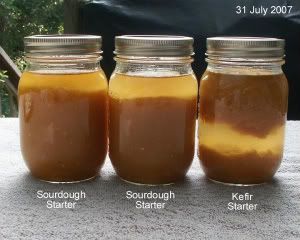I mean it's not like they had nice Mr. Fleischmann's ready made Yeast sitting waiting at the local market.
Out of yeast? Don't worry: It's not hard to find/make/produce enough to make bread.
The feisty critters that make bread rise actually live all around us. In fact, the use of yeast in bread-making probably got its start accidentally, when "wild" yeast caused doughs meant for unleavened flatbreads to ferment.
To this day, many bakers still use "wild" yeast to make bread, especially in San Francisco, a city famous for its sourdough. To make sourdough, bakers use a "starter," a piece of dough in which yeast is continually reproducing with the help of regular doses of flour from the baker. The yeast that gets the starter "started" usually comes from the air in the kitchen or bakery where the bread is made, but some starter recipes also use store-bought yeast.
Sourdoughs and other raised breads also differ from one another because of the yeast used, one could crush some unwashed grapes (they would need to look dusty to work, this is the same yeast used in the fermentation process for wine), some beer should do it too, leave it out to capture wild yeast.
But my favorite so far has been a Christmas present I got from a very smart Cattleman who knows his woman and got her a piece of the world famous Carl Griffiths Oregon Trail 1847 starter. It even has excellent provenance certificate to prove it. ;) Cost? One SASE, how can you beat that?
Now the thing about Sourdough , in order for it to be successful, is very much like a new romantic relationship, it requires a wee spot of your attention almost every day at first (later you can neglect it for weeks on end and it will still be there like a faithful er...partner) and it will NOT put out for at least 15 days. If your impatient or can't commit to at least stirring the thing every day or so? This is not the method for you. NO Free yeast for you!
Once you have your starter you can take off a bit and make a second one to play with changing the flour combinations to your taste, like added rye flour, a portion of whole wheat, where ever your new found sense of adventure and confidence in your bread making skills will take you.
****Note: sourdough starter does look like a science experiment gone wrong, it either bubbles and pops at you or if you've forgotten to stir it it will separate and have a darkish liquid sitting on top. First time I saw that I actually threw it out thinking I was about to poison my family, just stir it up again.
Mine looked just like this one I found on the web.

These are some more images I found just to give you an idea on what it might look like. ( so you don't scare yourself like I did.)
Why don't stinky, vile bacteria and yeasts take hold instead? In general , chemistry is working in your favor. Most wild bacteria in the air feed best on sugars and don't do as well with the starches in a starter. As soon as the good bacteria begin to take hold, they produce lactic and acetic acids as byproducts, making the starter an even less hospitable environ for other bacteria. This lactic acid, the same as can be found in yogurt and buttermilk, is also what gives sourdough it's mild, sour bite. The process also produces small amounts of watery ethanol on the surface of the starter. ( The stuff that scared me first time around.)
Do not keep sourdough if it is green or smells like paint, vomit or something equally vile.
If it smells like beer? Good on ya!!!! Just saying is all....
3 comments:
That looks so totally crazy LOL. But I've been getting more interested in how things were done 'in the old days' because we tend to rely so much on stores these days, it freaks me out to think about what could happen if anything goes wrong - major power outages, catastrophy, etc... most of us don't have a single clue how to REALLY cook anymore and I think it's important to learn. I've been thinking of starting to can foods as well, make jams and jellies, etc.... so I might even attempt this science experiment, since I LOVE sourdough bread SO MUCH lol.
I hear you Kez, we once were in an Ice Storm and were with out power for almost two weeks. I will never be caught with my panties down again. I want to know that I can at least provide heat and a good diet that does NOT depend on a grocery store, (NO power = no money as the bank machines do not work, which sucks beyond measure) when those times come around again. It actually helped me to see the value in being able to do for myself from scratch. Do it enough and it is no longer hard but easy as pie.
Remember if you buy flour in bulk, put it in the freezer for 48 hours before you store it away. That kills any bad things that could make your Flour turn.
I will always have food in storage for such an eventuality, I will now always have a way to cook it and the kiddos will not skip a beat, it will be an adventure instead of an emergency.
P.S. Canning is much easier then you might think and it saves a poop load of $$$$$ even if you are buying your fruits etc from the store (on sale of course). I make all my own Jams and Jellies, they helped to fill Christmas baskets for family one year ot two when we are broke. Now when the family ( even the little kids) get "presents" they are kinda pissed, go figure.
Post a Comment